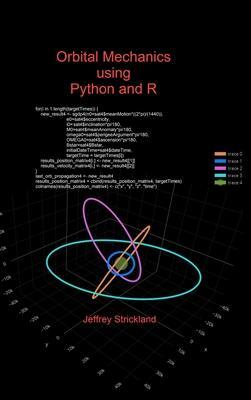Orbital Mechanics using Python and R

Orbital Mechanics using Python and R
This book describes the mechanics or physics of resident space objects (RSOs) in orbits due to the gravitational force of the central mass, like the Earth. In other words, it's about the obit of satellites and other RSOs. Part 1 applies the laws of Newton and Kepler, considers 2-body and N-body problems, and explores Jacobi's constant and Lagrangian points. Using calculus, geometry, trigonometry, and algebra, it develops the equations of orbits and motion, transforms reference frames to other frames, like Cartesian to True Equator, Mean Equinox (TEME). The book investigates orbital maneuvers with applications like Hohmann transfers, and interplanetary trajectories hyperbolic departures. We develop the orbital parameters, like the semilatus rectum, mean anomaly, eccentricity, inclination, and argument of periapsis. Part 2 explores and implements the NORAD two-line element (TLE) set and uses the content to propagate state vectors( position and velocity) to plot orbits and ground tracks. We employ the SGD4 (LEO) propagator and SPD4 (deep space) propagator to validate orbits against Revisiting Spacetrack Report #3. We then use the results to project orbits forward in time and to simulate from selected orbital elements.
PRP: 848.12 Lei
Acesta este Pretul Recomandat de Producator. Pretul de vanzare al produsului este afisat mai jos.
763.31Lei
763.31Lei
848.12 LeiLivrare in 2-4 saptamani
Descrierea produsului
This book describes the mechanics or physics of resident space objects (RSOs) in orbits due to the gravitational force of the central mass, like the Earth. In other words, it's about the obit of satellites and other RSOs. Part 1 applies the laws of Newton and Kepler, considers 2-body and N-body problems, and explores Jacobi's constant and Lagrangian points. Using calculus, geometry, trigonometry, and algebra, it develops the equations of orbits and motion, transforms reference frames to other frames, like Cartesian to True Equator, Mean Equinox (TEME). The book investigates orbital maneuvers with applications like Hohmann transfers, and interplanetary trajectories hyperbolic departures. We develop the orbital parameters, like the semilatus rectum, mean anomaly, eccentricity, inclination, and argument of periapsis. Part 2 explores and implements the NORAD two-line element (TLE) set and uses the content to propagate state vectors( position and velocity) to plot orbits and ground tracks. We employ the SGD4 (LEO) propagator and SPD4 (deep space) propagator to validate orbits against Revisiting Spacetrack Report #3. We then use the results to project orbits forward in time and to simulate from selected orbital elements.
Detaliile produsului









